How to Start A Black Soldier Fly Bin: A Step-by-Step Setup Guide
- February 29, 2024
- 1 comment
Black Soldier Fly (BSF) composting stands at the forefront of sustainable living, offering an innovative approach to efficient waste management. By leveraging the unique capabilities of BSF larvae to convert organic waste into valuable protein and fat, this method presents a transformative solution for reducing waste and supporting sustainable agriculture.
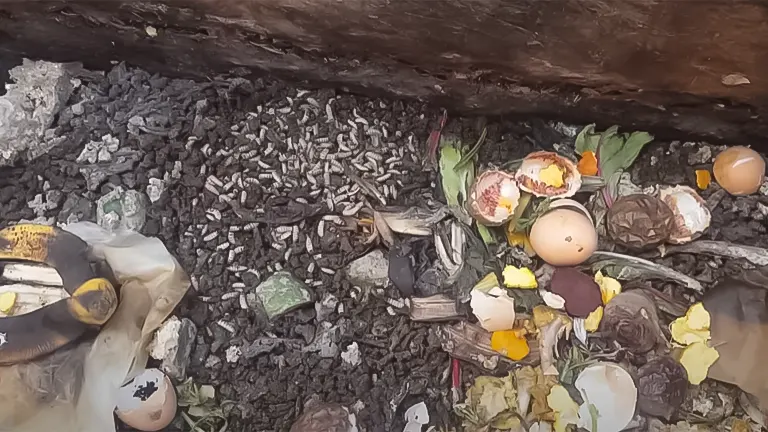
Drawing on firsthand experience, this guide succinctly outlines an 8-step process to establish and sustain a productive BSF bin, providing essential insights and practical tips to navigate the intricacies of this eco-friendly composting system successfully.
List of How To Start A Black Soldier Fly Bin:
- Sourcing Your BSF Larvae
- Preparing the Bin Setup
- Feeding Your Larvae
- Managing the Habitat
- Facilitating the Pupation Process
- Attracting Adult Flies for Repopulation
- Harvesting and Utilizing the Larvae
- Monitoring and Troubleshooting
Understanding Black Soldier Flies
Black Soldier Flies (BSF) distinguish themselves significantly from the common housefly through their unique ecological role and behavior. Adapted to thrive in warmer climates, these flies pose no harm to humans as they do not transmit diseases nor show interest in human habitats or foods.
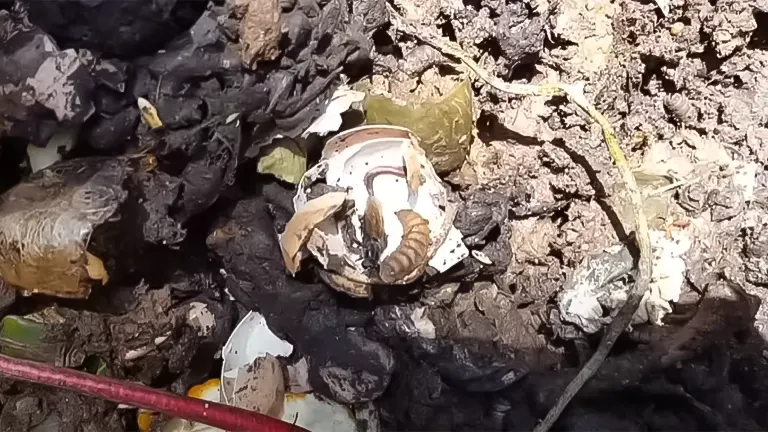
The true value of BSF lies in their larvae stage, where they exhibit an extraordinary capacity to consume vast amounts of organic waste. This remarkable ability enables them to convert discarded kitchen scraps, agricultural by-products, and even manure into valuable resources: high-quality protein and fat.
These outputs can serve as a sustainable feed for livestock, aquaculture, and pets, thereby playing a crucial role in the circular economy of waste management. By integrating BSF into sustainable farming practices, we can significantly reduce waste footprints while simultaneously creating a renewable source of animal feed, highlighting their importance in ecological sustainability and resource efficiency.
Step 1: Sourcing Your BSF Larvae
Initiating a Black Soldier Fly (BSF) bin requires first acquiring the larvae, which are the cornerstone of the composting process.
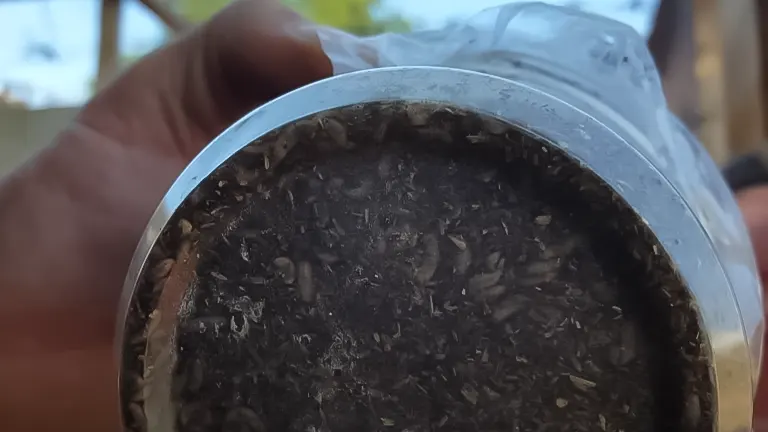
After efforts to attract BSF naturally to my property failed, I turned to a reliable supplier in Austin, Texas, where for a modest fee of $30, I obtained roughly a thousand larvae.
This initial quantity is ample to commence the composting journey, highlighting the importance of sourcing quality larvae to kickstart the ecosystem in your bin.
Step 2: Preparing the Bin Setup
Constructing a conducive environment for the BSF larvae is vital for their development and the overall success of the composting system.

My prototype bin incorporates a comprehensive drainage system to mitigate moisture accumulation and layers of weed mat over hardware cloth to ensure structural stability and appropriate water flow.
These elements are crucial in creating an environment that supports larval growth and maintains the structural integrity of the bin.
Step 3: Feeding Your Larvae
The nutritional regimen for BSF larvae starts with moistened grains, like rolled oats, providing essential moisture through their diet.
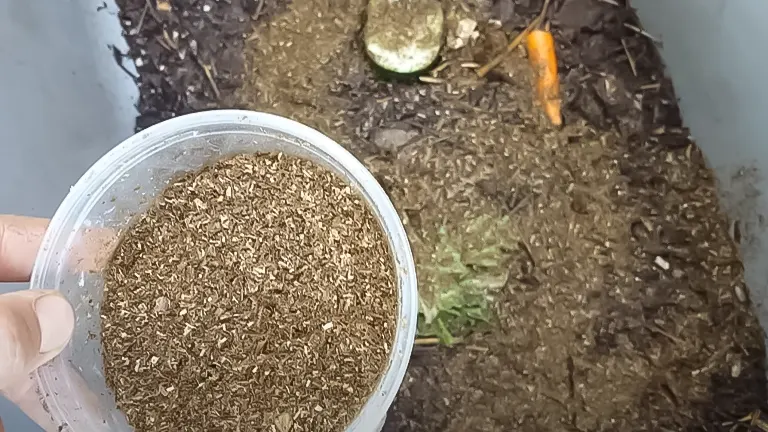
Introducing a mix of kitchen leftovers, including vegetables and fruits, diversifies their diet but requires gradual incorporation to prevent overfeeding and deter pests.
This balanced approach to feeding underscores the necessity of monitoring food intake and variety for optimal larval health.
Step 4: Managing the Habitat
Effective habitat management is characterized by vigilant monitoring of moisture levels and cleanliness within the bin.

Unchecked excess in food or water can foster mold growth, thus adjusting feed quantities to match larval consumption is critical. This proactive management ensures the bin environment remains conducive to larval growth and health.
Step 5: Facilitating the Pupation Process
As larvae reach maturity, they instinctively seek a suitable place to pupate. Incorporating ramps and designated exits in the bin design facilitates this natural progression, allowing larvae to self-harvest.
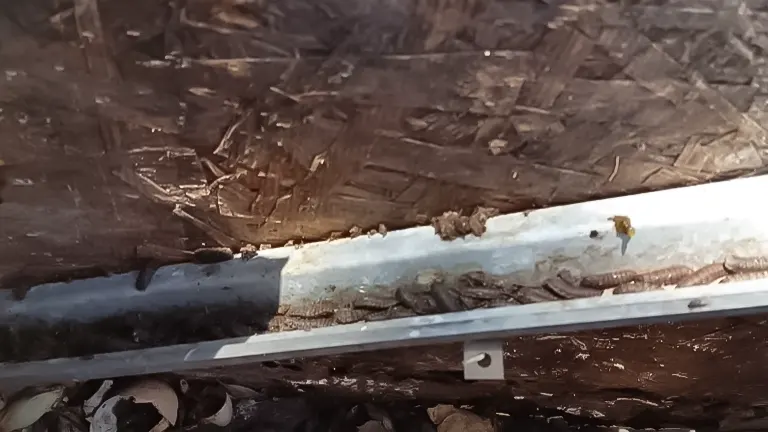
This feature not only eases the harvesting process but also promotes a continuous cycle of reproduction, vital for the bin’s sustainability.
Step 6: Attracting Adult Flies for Repopulation
Maintaining a thriving BSF population necessitates attracting adult flies to lay eggs. The bin’s mild odor and the introduction of fresh vegetation act as natural attractants.
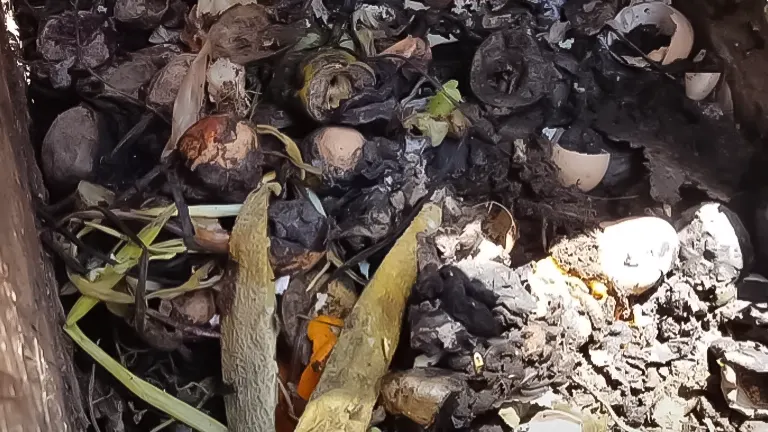
Ensuring the bin is both accessible and inviting is critical for ongoing egg deposition and larva production, essential for the system’s longevity.
Step 7: Harvesting and Utilizing the Larvae
Harvested BSF larvae offer a high-protein feed option for a variety of farm animals, including poultry and fish, showcasing the remarkable waste-to-nutrient conversion capability of BSF composting.
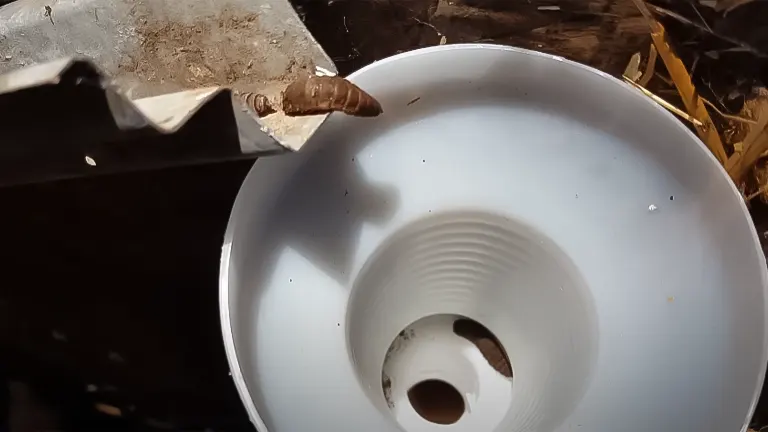
This efficient transformation highlights the significant role of BSF composting in enhancing sustainable agricultural practices by providing a renewable feed source.
Step 8: Monitoring and Troubleshooting
Continuous observation and troubleshooting are paramount for the sustained productivity of a BSF bin. Early identification and correction of issues, such as inadequate ramp access or excessive moisture, are essential in averting potential complications.
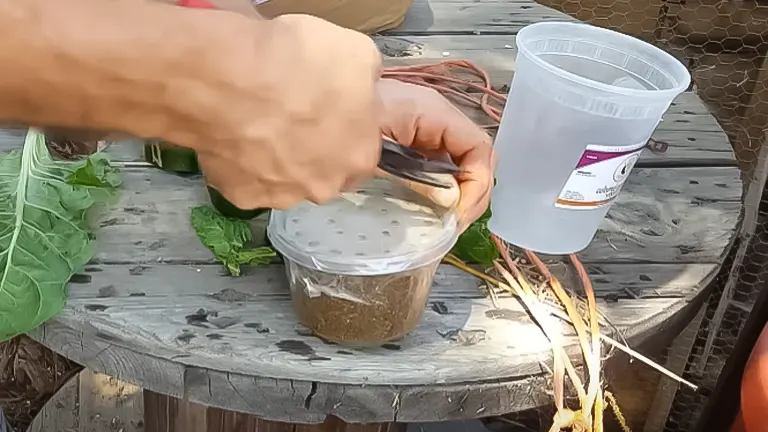
This vigilance ensures the bin remains an effective component of waste management strategies, underscoring the importance of regular oversight in the composting process.
Additional Tips For Safety and Cleanliness
When starting a Black Soldier Fly (BSF) bin, prioritizing safety and cleanliness is crucial to ensure a successful and hygienic operation. Here are five essential tips to maintain both safety and cleanliness in your BSF composting endeavors:
- Regularly Monitor and Manage Moisture Levels: Excessive moisture can lead to odors and attract unwanted pests, while too little moisture can hinder the larvae’s development. Maintain a balance by adding dry material or water as needed, and ensure your bin has adequate drainage to prevent waterlogging.
- Secure Your Bin Against Rodents and Pests: Place your bin on a raised platform or add barriers to prevent access by rodents and other pests. A tightly fitted lid or mesh covering can deter flies and insects from entering the bin while allowing for necessary air circulation.
- Use a Dedicated Space and Tools: Designate a specific area for your BSF bin that is away from living spaces and food preparation areas. Use separate tools for managing your BSF bin, such as trowels or gloves, to prevent cross-contamination.
- Practice Good Hygiene: After handling your BSF bin or the larvae, wash your hands thoroughly with soap and water. Clean any surfaces or tools that come in contact with the bin regularly to maintain a sanitary environment.
- Educate Yourself on Proper Waste Handling: Not all organic waste is suitable for BSF composting. Familiarize yourself with what types of waste are appropriate and safe for your BSF bin to avoid introducing harmful pathogens or chemicals into the system. For instance, avoid adding processed foods, oils, and toxic plants that could harm the larvae or the quality of the compost.
Related Articles:
- Best Bedding For Chickens
- Best Safe Chicken Coop Heater
- 8×8 Chicken Coop Plans
- Turning a Shed Into a Chicken Coop
- How to Make a Chicken Coop Out of Pallets
- Best Sand for Chicken Coop
- How To Insulate a Chicken Coop
- How To Heat a Chicken Coop
- How To Keep Water from Freezing in Chicken Coop
- How to Build a Chicken Coop
- How To Build Chicken Nesting Boxes
- How to Raise Happy and Healthy Chickens in Your Backyard
- When Can Chicks Go Outside? Timing and Tips for a Smooth Transition
- 12 Reasons why Ducks are Better than Chickens
- Best Automatic Chicken Coop Doors 2024: Expert Reviews & Buyer’s Guide
- Best Fans for Chicken Coop 2024: Effective Cooling Solutions Reviewed
- Designing the Perfect Low-Maintenance Chicken Coop: Your Ultimate Guide
- Transforming Chicken Feed: My DIY Black Soldier Fly Bin Experience
- Backyard Chickens: A Step-by-Step Guide for First-Timers
Concluding Thoughts
Adopting Black Soldier Fly (BSF) composting marks a significant stride towards achieving sustainability and optimizing organic waste management practices. This detailed guide lays the foundation for anyone to successfully set up and maintain a productive BSF bin, paving the way for a greener future. Although the journey demands diligence and meticulous care, the outcomes are immensely rewarding. Practitioners are endowed with nutrient-rich compost and an eco-friendly feed source for animals, epitomizing the essence of a circular economy and the ethos of environmental conservation.
Frequently Asked Questions
- What are Black Soldier Flies (BSF), and why are they important for composting?
Black Soldier Flies are beneficial insects known for their larvae’s ability to rapidly decompose organic waste into nutrient-rich compost. They play a critical role in sustainable waste management and can transform kitchen scraps and agricultural waste into high-quality animal feed. - How do I start a Black Soldier Fly bin?
Starting a BSF bin involves sourcing BSF larvae from a reputable supplier, setting up a suitable bin with proper drainage and ventilation, and introducing organic waste for the larvae to consume. Regular monitoring and maintenance are essential to ensure the bin’s success. - Where can I obtain BSF larvae to start my bin?
BSF larvae can be purchased online from specialized suppliers or, in some cases, sourced from existing BSF composting communities. Ensure you’re buying from a credible source to get healthy and viable larvae. - What materials do I need to construct a BSF bin?
A basic BSF bin can be made from a variety of materials, including wood, plastic containers, or metal bins. Key features include a secure lid, drainage holes at the bottom, and a ramp or escape route for mature larvae to harvest themselves. - What can I feed the BSF larvae in my bin?
BSF larvae are voracious eaters and can consume most organic kitchen scraps, including fruits, vegetables, coffee grounds, and even small amounts of meat and dairy. Avoid feeding them inorganic materials, toxic plants, and excessively processed foods. - How do I maintain the optimal conditions in my BSF bin?
Maintain a moist but not soggy environment, ensure adequate aeration to prevent foul odors, and keep the bin in a warm location out of direct sunlight. Monitor the bin regularly to adjust feeding rates and manage moisture levels. - Can I use a BSF bin indoors?
Yes, a BSF bin can be kept indoors if managed properly to prevent odors and escapees. However, it’s typically recommended to place bins outdoors in a sheltered, warm location to mimic the natural environment of the BSF. - How do BSF bins benefit my garden or farm?
BSF composting converts organic waste into high-quality compost that can enhance soil fertility and structure. Additionally, the larvae can be used as a high-protein feed for poultry, fish, and reptiles. - What do I do with the mature BSF larvae?
Mature larvae can be harvested and used as animal feed, or allowed to pupate into adult flies to perpetuate the composting cycle. Some systems are designed to let larvae self-harvest, making the process easier. - Are there any common problems with BSF bins, and how can I solve them?
Common issues include foul odors, incorrect moisture levels, and larvae escape. To mitigate these, ensure proper aeration, adjust moisture by adding dry material or water as needed, and secure the bin to prevent larvae from escaping. Regular maintenance and observation are key to addressing problems promptly.
We value your input! Please share your personal experiences and insights on starting a Black Soldier Fly Bin in the comments section below. Your stories and tips could greatly assist fellow enthusiasts in navigating the setup and maintenance of their own BSF bins, making a significant contribution to our community’s collective knowledge. Your feedback is essential in helping others make well-informed decisions on their sustainable waste management journey!

Edward Smith
Forestry AuthorWoodworking is about more than crafting; it's a harmonious connection with nature, mastering tools, and preserving our environment. I'm here to share my knowledge and experiences with you, forging a future where we can embrace wood's beauty and utility while safeguarding our forests' health and diversity.



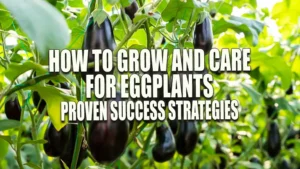

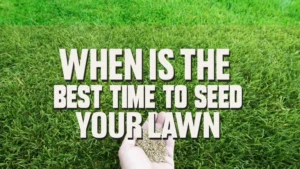
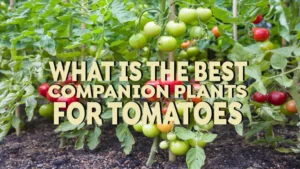






Very good info. Thanks.
Jaime
March 22, 2024 8:28 pm